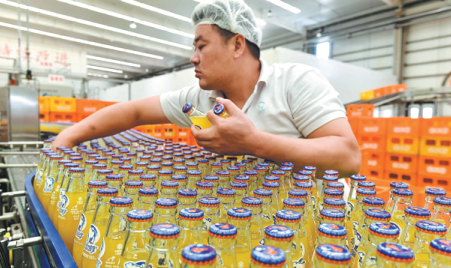Fizz, fortunes of classic soft drinks rising

A worker is busy at the production line of a Beibingyang factory in Maanshan, Anhui province. LI YUANBO/FOR CHINA DAILY
Dai Jiangxiao took a huge gulp of her Asia Sarsae soda. With its unique flavor, the drink hit the spot.
Living in Guangzhou, capital of Guangdong province, Dai said she regarded Asia Sarsae, a sarsaparilla soft drink similar to root beer, as the taste of the city.
The iconic drink has a strong, minty flavor like fengyoujing, a Chinese herbal remedy to relieve pain. While it has yet to rise to prominence throughout China, it has captured the hearts of many local residents.
The brown, carbonated drink, first rolled out in Guangzhou in 1946, using extracts from Ilex asprella, a traditional Chinese medicine herb used to "clear heat". According to traditional Chinese medicine doctrine, "heat" trapped within the body can cause many ailments, especially for people who live in hot, humid places.
In the days when air conditioners were not widely affordable, residents in Guangdong had a habit of drinking chilled Asia Sarsae to refresh themselves on sweltering summer days.
"I still remember my friends and I swilling the soda with a straw from a white plastic bag in the 1980s," recalled He Wenfeng, CEO of Guangzhou Xph Asia Beverage, which produces the drink. "Glugging the drink was typical during the summers of my childhood."
However, Asia Sarsae soon fell out of favor as international beverage giants like Coca-Cola and Pepsi-Co entered the Chinese market in the 1990s. "Asia Sarsae nearly disappeared in the late 1990s and early 2000s," He said.
Asia Sarsae was not the only domestic drink brand losing its market share. Once served at state banquets, Beibingyang, a soft drink brand rooted in Beijing, was barely seen in the 1990s. Another Chinese cola brand, Tianfu, previously the country's top-selling soft drink in the 1980s, saw its market share plunge to only 1 percent in 2005.
But domestic drinks have made a comeback over the past decade after successful rebranding.
"The rise of Asia Sarsae was boosted by consumers' nostalgia for their childhood and a brand-new image of the old drink," He said. According to the CEO, 80 million bottles of Asia Sarsae were sold in 2019, and sales volume surpassed 100 million bottles last year.
"The taste of fengyoujing is the soul of our drink," he said, adding that while keeping the taste unchanged, the company has improved the formula of the drink to make it healthier.
Asia Sarsae has rebranded itself to appeal to young consumers by offering diversified products, such as low-calorie soda and fruit-flavored soft drinks, and by participating in online shopping festivals.
The company has also expanded its cooperation with convenience stores and famous Cantonese restaurants like Tao Tao Ju to lure more young customers, he noted.
"I rushed to buy an Asia Sarsae when I rediscovered the drink on a shelf," said Dai, who is in her 40s."The taste awakened my memories of school 20 years ago."
Other traditional Chinese soda brands have also staged comebacks over the past decade. Beibingyang achieved profitability only two months after it resumed production in 2011. Hankow Er Chang, a new beverage brand born from an old-time classic in Wuhan, was catapulted into the limelight by marrying trendy cultural elements with eye-catching designs.
"The revival of domestic brands not only helps remind people of their childhoods but also wins the hearts of the younger generation through continuous innovation," He said. "It is also an important channel for people, especially foreigners, to get a taste of the city."



 Print
Print Mail
Mail

